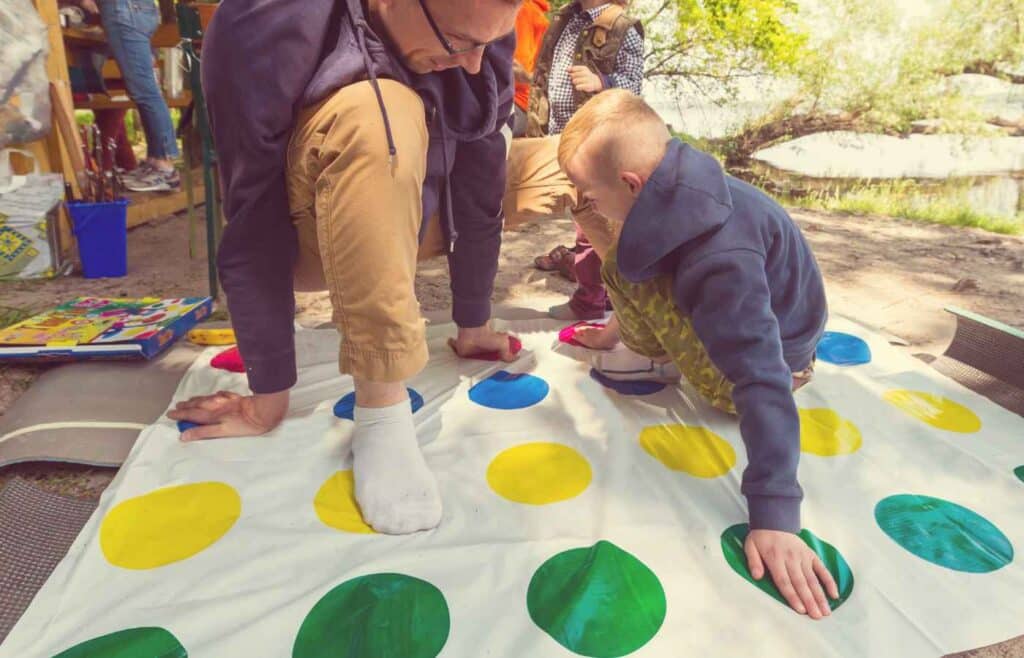In today’s fast-paced world, it’s becoming increasingly important to carve out quality time with our loved ones.
Family game nights are a perfect way to bring everyone together, fostering bonding, quality family time, laughter, and friendly competition.
And, according to science, the family that plays together stays together.

Whether you’re a seasoned game night enthusiast or looking for fresh ideas, this comprehensive list will provide you with the ultimate collection of fun and engaging games to enjoy with your family.
From classic board games to interactive digital experiences, we’ve got you covered.
So, let’s dive in and discover the best family game night ideas that will make your evenings unforgettable!
Would You Rather
One of the best games that the entire family can play without any materials is “Would You Rather.” In this game, players are presented with a series of hypothetical situations and must choose between two options, both of which are usually challenging or amusing.
Here’s how to play:
- Gather all family members in a circle or sit around a table.
- Decide who will go first, either by volunteering or taking turns.
- The first player poses a “Would You Rather” question, offering two options. For example, “Would you rather have the ability to fly or be invisible?”
- Each player takes turns answering the question, explaining their choice and reasoning behind it.
- After everyone has given their answer, the next person takes their turn by posing a new “Would You Rather” question to the group.
- Continue the game, with each player taking turns asking new thought-provoking questions and discussing their choices.
- Feel free to get creative with the questions and adapt them to the age range and interests of your family members.
- The game can continue for as long as everyone wants to play, or you can set a predetermined number of rounds.
“Would You Rather” is an engaging and interactive game that sparks conversations, encourages critical thinking, and provides insights into the preferences and perspectives of each family member. It can be enjoyed by all ages, including younger kids. Enjoy the laughter, debates, and surprises that come with this fun-filled game!
Charades

Charades is a classic game that requires no materials and is perfect for family game nights. It involves acting out words or phrases without speaking while others try to guess what is being portrayed. Here’s how to play:
- Divide the players into two teams. If there are only a few players, you can play as a single group.
- One person from the first team acts as the “actor” and chooses a word or phrase to portray silently.
- The actor can use gestures, body movements, and facial expressions to communicate the word or phrase.
- The actor starts performing the charade in front of the other players, who are the “guessers.”
- The guessers from the actor’s team have a limited time to figure out the word or phrase being acted out.
- The guessers can call out their answers or make guesses individually or as a group.
- If the team correctly guesses the word or phrase within the time limit, they earn a point.
- If the time limit is reached without a correct guess, the other team gets a chance to steal and make a guess.
- After each round, the teams alternate with a new actor and continue until a predetermined score or number of rounds is reached.
- The team with the highest score at the end of the game wins.
To make the game more challenging and engaging, you can set categories for the words or phrases, such as movies, animals, books, or famous people. This adds an extra layer of fun and variety to the game. Remember to keep the acting lively, and enjoy the laughter and excitement that comes with deciphering and performing charades together as a family.
Jenga

Jenga is a classic and suspenseful game that requires a steady hand and strategic thinking. The game consists of a tower made up of stacked wooden blocks, and the objective is to carefully remove blocks from the tower without causing it to collapse. Here’s how to play:
- Start by setting up the Jenga tower. Arrange the wooden blocks in a grid pattern, with three blocks placed side by side horizontally, followed by three blocks placed side by side vertically on top of the first layer. Continue alternating the pattern until you have a tower of 18 levels or as many levels as you desire.
- Once the tower is set up, players take turns. The youngest player usually goes first, but you can decide the order based on preference or by random selection.
- On their turn, a player selects one block from any level of the tower, except the topmost completed level, and carefully removes it using only one hand. They must avoid touching or moving other blocks during this process.
- After successfully removing a block, the player places it on top of the tower, creating a new level.
- Players can tap or test blocks for stability before selecting one to remove. However, once a player touches a block and begins to remove it, they must commit to that block and complete the move.
- The game continues with each player taking turns removing and stacking blocks until the tower becomes unstable and collapses.
- The player who caused the tower to collapse is considered the “loser” of that round.
- Optionally, you can play multiple rounds and keep track of the number of collapses for each player. The player with the fewest collapses at the end is the overall winner.
Jenga is a game that combines skill, patience, and a bit of luck. As the tower becomes increasingly unstable, tension builds, and each move becomes more nerve-wracking. Whether you’re playing with family or friends, Jenga offers an exciting and engaging experience that will keep everyone on the edge of their seats!
Celebrity
Celebrity is a lively and fun game game that challenges players’ knowledge of famous people and their improvisation skills. It’s a game that encourages teamwork, creativity, and quick thinking. Here’s how to play:
- Gather a group of players and divide them into two teams.
- Write the names of various famous people, such as actors, musicians, athletes, or historical figures, on separate pieces of paper. Fold the papers and place them in a bowl or hat.
- Decide on the number of rounds you want to play. Each round will have a different set of rules.
- In the first round, one member from Team A begins as the “clue giver.”
- The clue giver takes a name from the bowl without looking and tries to describe the celebrity to their team without using the celebrity’s name.
- The clue giver can use any verbal clues, but they cannot say the person’s name, any part of their name, or provide direct hints. They can use descriptions, actions, or quotes associated with the celebrity to give clues.
- The team members have a limited time, usually around 60 seconds, to guess the celebrity based on the clues given by the clue giver. They can shout out their guesses, and the clue giver can provide feedback (e.g., “Yes,” “No,” “Close,” etc.).
- If the team guesses correctly within the time limit, they earn a point, and play moves to the next team with a new clue giver.
- Continue alternating between teams and clue givers until all the names in the bowl have been used.
- In the subsequent rounds, you can introduce new rules, such as using only one-word clues or acting out the celebrities without speaking.
- After completing the predetermined number of rounds, tally the points for each team.
- The team with the highest score at the end of the game is declared the winner.
Celebrity is a game that brings laughter, excitement, and friendly competition as players try to guess famous names and showcase their improvisation skills. It’s a perfect choice for gatherings and parties, allowing everyone to participate and enjoy the thrill of celebrity-themed guessing games.
Bingo

Bingo is a classic and easy-to-play game that brings fun and excitement to players of all ages. It’s a game of chance that involves marking off numbers on a grid as they are called out. Here’s how to play:
- Distribute bingo cards to each player. These cards consist of a grid filled with random numbers.
- Provide each player with markers, such as small coins or bingo daubers, to cover the called numbers on their card.
- Designate one person as the caller or use a random number generator.
- The caller randomly selects a number from a pool or generates a number using a random number generator.
- As the numbers are called out, players check their cards to see if they have the called number.
- If a player has the called number on their card, they cover it with a marker.
- The game continues with the caller announcing new numbers, and players marking off those numbers on their cards.
- The objective is to be the first player to mark off a specific pattern on their card, such as a line (horizontal, vertical, or diagonal) or a full house (covering all the numbers on the card).
- Once a player achieves the specified pattern, they call out “Bingo!” to notify others.
- The caller verifies the player’s numbers by checking their card against the called numbers.
- If the player’s claim is valid, they are declared the winner of that round.
- Optionally, you can play multiple rounds and keep track of each player’s wins to determine the overall winner.
Bingo is a game that requires luck and attentiveness. It’s a great choice for gatherings, community events, or family game nights, offering a simple and enjoyable experience for players of all ages. Get ready to shout “Bingo!” and experience the thrill of winning as you mark off the numbers on your card!
Mad Libs
Mad Libs is a hilarious and creative word game that sparks imagination and laughter. It’s a game where players fill in the blanks in a story with different types of words (nouns, verbs, adjectives, etc.) without knowing the context. Here’s how to play:
- Start by selecting a Mad Libs story or create your own. Mad Libs typically have a predetermined story structure with blank spaces for various types of words.
- Instruct the players to gather and provide different types of words based on categories like nouns, verbs, adjectives, adverbs, and more. You can set a specific number of words required for each category.
- Players take turns, and the person leading the game asks for a specific type of word without revealing the context or sentence.
- Each player secretly writes down their word and hands it to the person leading the game.
- Once all the words are collected, the person leading the game inserts the submitted words into the corresponding blanks in the story.
- The completed Mad Libs story is then read aloud to everyone, incorporating the chosen words into the narrative.
- The unexpected combinations of words often result in amusing and nonsensical sentences, leading to laughter and enjoyment.
- Players can take turns reading their completed Mad Libs stories or pass them around for others to read.
- Optionally, you can encourage players to be creative and imaginative with their word choices, resulting in even funnier and more entertaining stories.
- Repeat the process with different Mad Libs stories and categories for continued laughter and amusement.
Mad Libs is a game that combines wordplay, humor, and creativity. It’s a fantastic choice for parties, road trips, or any gathering where you want to engage in collaborative storytelling and have a good laugh. It’s best for older kids who have already learned about the parts of speech.
Jeopardy
Jeopardy is a popular trivia game show that can be adapted for a fun and interactive family game night. While the official Jeopardy game requires materials like a game board and buzzers, you can create a simplified version at home without any special equipment. Here’s how to play:
- Divide the players into two or more teams.
- Designate one player as the “host” who will ask the questions and keep score.
- The host prepares a list of categories and assigns point values to each question, such as 100, 200, 300, etc.
- Each category should have a range of Jeopardy-Style Questions with varying difficulty levels.
- The host reads out a category and point value (e.g., “Movies for 200”).
- The first person to team to buzz in or raise their hand gets the opportunity to answer the question.
- The host reads the corresponding question aloud, and the team has a limited time to provide the correct answer.
- If the team answers correctly, they earn the points associated with that question. If they answer incorrectly, the other teams have a chance to steal and answer.
- After each question, the host keeps track of the scores and moves on to the next category and point value.
- Continue playing until all the questions have been answered or until you reach a predetermined number of rounds.
- The team with the highest score at the end of the game is declared the winner.
To make the game more engaging, you can add a visual component by creating a makeshift game board with categories and point values on a whiteboard or poster board. You can also personalize the questions to include topics that interest your family members, such as history, science, sports, or pop culture.
Jeopardy is a fantastic game that challenges your knowledge, sparks friendly competition, and promotes learning in an entertaining way. Enjoy the thrill of answering questions and see who emerges as the ultimate Jeopardy champion in your family!
Hedbanz

Hedbanz is an entertaining and interactive guessing game that requires no materials beyond a set of imagination and creativity. It’s a perfect game for family gatherings or game nights. Here’s how to play:
- Distribute a headband to each player and attach a card holder to it. Alternatively, you can use sticky notes or tape to attach cards to players’ foreheads if headbands are not available.
- Shuffle a deck of Hedbanz cards and place them face-down in the center of the playing area.
- Each player takes a card from the deck without looking at it and inserts it into their card holder or sticks it to their forehead.
- Players must keep their card hidden from their view but visible to other players.
- The youngest player goes first and asks a yes-or-no question to the group, trying to guess the object or person on their card. For example, “Am I an animal?”
- Other players can only respond with “yes” or “no.”
- Based on the answer, the guessing player can make an additional guess or ask another question to narrow down their identity.
- Play continues clockwise, with each player asking questions and making guesses until someone correctly identifies the object or person on their card.
- The player who correctly guesses their card removes it and keeps it as a point.
- The game continues with new cards being drawn, and players take turns guessing until a predetermined number of rounds or points is reached.
- The player with the most points at the end of the game is declared the winner.
Hedbanz is a game that sparks laughter, encourages critical thinking, and provides an opportunity to discover interesting facts about various objects and characters. It’s a great way to engage the whole family and enjoy an interactive and entertaining game night.
Chopped
Chopped is a thrilling cooking competition game inspired by the popular TV show of the same name. It challenges players to think on their feet, be creative with limited ingredients, and showcase their culinary skills. Here’s how to play a modified version of Chopped at home:
- Divide the players into teams or compete individually.
- Determine the number of rounds you want to play. Each round represents a different course of the meal: appetizer, main course, and dessert.
- Before each round, reveal a “mystery basket” of ingredients that must be used in that particular course. The ingredients should be a mix of common and unconventional items.
- Set a time limit for each round, such as 20 or 30 minutes, depending on the complexity of the dish.
- Players must quickly brainstorm and plan their dishes based on the ingredients in the mystery basket.
- Once the time starts, players have to cook their dishes using the provided ingredients and any additional pantry items.
- Encourage creativity and experimentation with flavors and techniques to make unique and delicious dishes.
- At the end of each round, players present their dishes to a panel of judges (other players or family members) and explain their choices and cooking methods.
- The judges evaluate each dish based on taste, presentation, creativity, and the use of the mystery ingredients.
- After scoring and feedback, move on to the next round with a new mystery basket and repeat the process.
- Once all the rounds are completed, tally up the scores for each player or team.
- Declare the player or team with the highest total score as the winner of the Chopped competition.
Chopped is an exciting and interactive game that combines culinary skills, teamwork, and creativity. It challenges players to think outside the box, adapt to unexpected ingredients, and showcase their ability to create delectable dishes under pressure. Prepare for a delicious and competitive cooking experience that will test your culinary prowess!
Apples to Apples
Apples to Apples is a popular and hilarious party game that sparks creativity, laughter, and friendly competition. While the official game comes with cards, you can play a modified version at home using just your imagination. Here’s how to play:
- Gather a group of players and designate one person as the “judge” for the round.
- The judge selects a word or phrase, known as the “prompt,” and announces it to the group. For example, the prompt could be “exciting.”
- Each player, except the judge, chooses a card from their imaginary hand that they believe best represents or relates to the prompt.
- The players simultaneously “play” their imaginary cards face-down in front of the judge.
- Once all the cards are placed, the judge reveals them and reads them aloud to the group.
- The judge then decides which card they feel best matches the prompt based on their own criteria (humor, creativity, relevance, etc.).
- The player who played the chosen card earns a point and becomes the judge for the next round.
- Repeat the process, with each player taking turns as the judge and selecting new prompts.
- Continue playing for as long as you like or set a predetermined number of rounds.
- The player with the most points at the end of the game is declared the winner.
Apples to Apples is a game that allows players to showcase their creativity and sense of humor as they try to match the prompt with the most entertaining or relevant imaginary card. Feel free to customize the prompts based on your family’s interests, adding more personalization and excitement to the game. Get ready for an evening filled with laughter and clever comparisons!
Bananagrams
Bananagrams is a fast-paced and addictive word game that requires quick thinking and word-building skills. It’s a great game for players of all ages, and the best part is that it comes in a compact, portable banana-shaped pouch. Here’s how to play:
- Start by distributing all the letter tiles facedown among the players. The number of tiles each player receives depends on the total number of players.
- In the beginning, all players simultaneously flip their tiles and start building their own personal crossword grid.
- Each player must use their tiles to create intersecting words, just like in a crossword puzzle.
- Players can rearrange their own words at any time to accommodate new letters.
- The objective is to use up all your tiles and be the first to complete your grid.
- If a player cannot use a particular letter or needs more letters, they have the option to exchange one or more of their tiles for new ones from the central pool. However, they must also take an equal number of tiles in exchange.
- If players run out of tiles in the central pool, they can choose to “peel” by taking an extra tile from the opponent’s pile. This applies a penalty of returning two tiles from their own pile back to the central pool.
- The game continues until one player has used up all their tiles and declared “BANANAS!”
- All players must then check the winner’s words for correctness. If any words are found to be invalid, the player is disqualified, and the game resumes until a valid winner emerges.
- Optionally, you can play multiple rounds and keep track of each player’s wins to determine the ultimate champion.
Bananagrams is a fun and fast-paced game that encourages creativity, vocabulary expansion, and quick thinking. With its portable and easy-to-learn nature, it’s an excellent choice for game nights, road trips, or any gathering where you want to engage in friendly wordplay and competition. Enjoy the challenge and excitement that Bananagrams brings!
Cupcake Wars
Cupcake Wars is a delightful and tasty competition inspired by the popular TV show. It allows players to showcase their baking skills, creativity, and teamwork in a quest to create the most delicious and visually appealing cupcakes. Here’s how to play a modified version of Cupcake Wars at home:
- Divide the players into teams or compete individually.
- Determine the number of rounds you want to play. Each round represents a different challenge or theme for the cupcakes.
- Before each round, reveal the challenge or theme to the players. It could be anything from a specific flavor, a unique ingredient, or a decorative style.
- Set a time limit for each round, such as 30 or 45 minutes, depending on the complexity of the cupcakes.
- Provide the players with a pantry of ingredients and decorations they can use to create their cupcakes. Include a variety of cake mixes, frosting, sprinkles, candies, fruits, and other baking essentials.
- Once the time starts, players must brainstorm ideas, plan their cupcakes, and execute their baking and decorating skills.
- Encourage creativity and experimentation with flavors, decorations, and designs to make extraordinary cupcakes that fit the challenge or theme.
- At the end of each round, have a tasting session where players present their cupcakes to a panel of judges (other players or family members) and explain the inspiration behind their creations.
- The judges evaluate each cupcake based on taste, presentation, creativity, and adherence to the challenge or theme.
- After scoring and feedback, move on to the next round with a new challenge or theme and repeat the process.
- Once all the rounds are completed, tally up the scores for each player or team.
- Declare the player or team with the highest total score as the winner of Cupcake Wars.
Cupcake Wars is a scrumptious and entertaining game that allows players to express their baking talents and artistic flair. It’s a perfect choice for those with a sweet tooth and a passion for creative desserts. Get ready to whip up some amazing cupcakes and indulge in a friendly competition that will satisfy both your taste buds and your creativity!
Three Truths and a Lie
Three Truths and a Lie is a popular icebreaker game that challenges players to guess which statement is false out of a set of four statements. It’s a game that encourages observation, critical thinking, and the ability to deceive others. Here’s how to play:
- Gather the players and designate one person to start as the speaker.
- The speaker thinks of four statements about themselves, three of which are true and one that is false.
- The speaker takes turns sharing the four statements with the other players, mixing them up and not revealing which one is the lie.
- The other players carefully listen to the statements and try to determine which one they believe is false.
- Once the speaker has shared the statements, each player takes turns stating which statement they think is the lie and providing a brief explanation for their choice.
- After everyone has made their guesses, the speaker reveals the false statement and the players who correctly guessed the lie earn points.
- Optionally, you can assign a point system, such as one point for each correct guess.
- Continue the game by rotating the role of the speaker to another player, who comes up with their own set of four statements.
Three Truths and a Lie is a game that encourages active listening, deduction, and the ability to craft believable statements. It’s a fun icebreaker that helps players get to know each other better and sparks interesting conversations. Prepare to test your detective skills and uncover the lie amidst the truths in this entertaining game!
Twister

Twister is a classic and physically engaging game that challenges players to contort their bodies and maintain balance while following the instructions given by a spinning wheel. It’s a game that brings laughter, flexibility, and friendly competition. Here’s how to play:
- Unroll the Twister mat on a flat surface, making sure there’s enough space for players to move around comfortably.
- Gather a group of players and have them remove their shoes to play the game barefoot.
- Designate one player as the spinner. This person is responsible for operating the spinner and giving instructions.
- Each player takes a turn spinning the spinner to determine the body part and the color of the next move.
- The spinner announces the instruction based on the spin (e.g., “Right hand on red”).
- All players, including the spinner, must follow the instruction and place the specified body part on the corresponding colored circle on the mat.
- As the game progresses, the positions become more challenging as players need to twist, stretch, and balance their bodies to maintain their positions on the mat.
- If a player falls or touches the mat with a body part other than the one instructed, they are eliminated from the game.
- The game continues with the spinner taking turns and giving new instructions until only one player remains standing.
- The last player standing is declared the winner of the round.
- Optionally, you can play multiple rounds and keep track of each player’s wins to determine the overall winner.
Twister is an exciting and physically interactive game that guarantees laughter, fun, and a little bit of flexibility. It’s a perfect choice for parties, family gatherings, or anytime you want to engage in some lighthearted physical activity. Get ready to twist, stretch, and have a blast with this classic game!
Hide and Seek
Hide and Seek is a timeless and thrilling game that combines stealth, strategy, and a sense of adventure. It’s a game where one person hides while others try to find them. Here’s how to play:
- Designate one player as the “seeker” and have them cover their eyes or count to a predetermined number (e.g., 20 or 30) facing a wall or closing their eyes.
- While the seeker counts, the other players scatter and find hiding spots.
- Players must find a spot within the designated playing area where they can hide without being easily seen.
- Once the seeker finishes counting, they begin searching for the hidden players.
- The seeker explores the area, looking for hidden players while calling out “Ready or not, here I come!” or a similar phrase to indicate they are actively seeking.
- Hidden players must remain quiet and still in their hiding spots, trying to avoid detection.
- If a player is found by the seeker, they are “caught” and must join the seeker in searching for the remaining hidden players.
- The game continues until all players are found, or a predetermined time limit is reached.
- The last player to be found becomes the seeker in the next round, and the game restarts.
- Optionally, you can establish boundaries or safe zones where players can go to avoid being tagged by the seeker.
- You can also set specific rules, such as no hiding in certain areas or establishing boundaries to make the game more challenging or tailored to the playing environment.
Hide and Seek is a game that brings excitement, suspense, and a sense of adventure. It’s perfect for outdoor spaces, large indoor areas, or any location with suitable hiding spots. Get ready to conceal yourself and embark on a thrilling search-and-find journey in this timeless game of Hide and Seek!
Spoons
Spoons is a fast-paced and entertaining card game that requires quick reflexes and attentiveness. It’s a game of speed and strategy where players aim to collect sets of matching cards and grab spoons before others do. Here’s how to play:
- Gather a deck of playing cards and place spoons in the center of the playing area, with the number of spoons one less than the number of players.
- Arrange the spoons in a circle, handles pointing outward, within reach of all players.
- Sit around the table or playing area with each player having a hand of four cards.
- The dealer starts the game by picking a card from the deck and deciding whether to keep it or pass it to the next player. The dealer continues passing cards until they receive a card they want to keep.
- The dealer then discards one card face-down to the player on their left.
- Players continue passing cards in a clockwise direction, discarding and receiving cards until someone collects a set of four matching cards (e.g., four Aces, four Sevens).
- Once a player has a set of four matching cards, they discreetly grab a spoon from the center of the table.
- As soon as other players notice a spoon being taken, they must also try to grab a spoon.
- The player who fails to grab a spoon is eliminated from the round.
- Remove one spoon from the center, reshuffle the deck, and deal four cards to each player again.
- Resume playing, with the remaining players trying to collect sets and grab spoons.
- The game continues until only one player remains, who is declared the winner of the round.
- Optionally, you can play multiple rounds, and the player with the fewest “lives” (lost rounds) is declared the overall winner.
Spoons is a lively and energetic game that guarantees laughter and excitement. It’s perfect for larger groups and can be enjoyed by players of all ages. Just be prepared for some fast-paced action as you compete to grab spoons and avoid elimination in this thrilling card game!
Cornhole

Cornhole is a popular outdoor game that involves tossing bean bags into a raised platform with a hole. It’s a fun and casual game that can be played by people of all ages. Here’s how to play:
- Set up the cornhole boards by placing them a specific distance apart. The standard distance is 27 feet for adults and 15 feet for children, but you can adjust it based on the skill level of the players.
- Divide players into two teams, with each team standing behind one of the boards.
- Each team has four bean bags of a specific color or design.
- The objective of the game is to score points by getting the bean bags into the hole or landing them on the board.
- Starting with one team, players take turns tossing their bean bags towards the opposite board.
- The player must throw the bean bag from behind the front edge of their board and aim to land it on the opponent’s board or, preferably, get it into the hole.
- If a bean bag lands on the board, it is worth 1 point. If it goes into the hole, it is worth 3 points.
- Players from the opposing team take turns throwing their bean bags, aiming to cancel out or outscore the other team’s points.
- After all eight bean bags have been thrown, the teams tally their scores for that round.
- The team with the highest score in the round adds the difference in points to their overall score.
- The game continues with alternating throws until one team reaches or exceeds a predetermined score, typically 21 points.
- The team that reaches the predetermined score first is declared the winner of the game.
Cornhole is a versatile game that can be played in backyards, parks, or even indoors with smaller, tabletop versions. It’s a fantastic choice for family gatherings, picnics, and social events, providing friendly competition and lots of fun. Grab your bean bags, aim for the hole, and enjoy the lively and exciting game of Cornhole!
Blank Slate
One of the best family games is Blank Slate, a game that consists of a deck of cards, each containing a word or phrase with a missing blank. Players take turns being the “slate reader” who reads the different words, while other players quickly write down their word or phrase that they think best completes the cue.
The simplicity of the game makes it accessible to players of all ages and skill levels. It’s easy to learn and can be enjoyed by both large and small groups, making it an ideal choice for family gatherings, parties, or casual game nights.
This is one of my family’s favorite games to play – it’s so much fun! Even younger children will enjoy it.
Simon Says: One person takes on the role of “Simon” and gives commands to the other players, such as “Simon says touch your nose.” Players must only follow the commands that start with “Simon says” and avoid following any other commands. It’s great for families with young children.
I Spy: One person selects an object within sight and says, “I spy with my little eye something that is [color/shape/hint].” Other players take turns guessing the object until someone correctly identifies it, and then it’s their turn to choose an object.
Twenty Questions: One player thinks of an object, and the others take turns asking yes-or-no questions to narrow down what it could be. The goal is to guess the object within 20 questions or fewer.
Statues: One person is the “museum curator” and plays music while others dance. When the music stops, the curator turns around, and all players freeze in their current position like statues. The curator tries to catch anyone moving, and those caught are out of the game. The last person remaining becomes the next curator.
UNO: A classic card game where players take turns matching colors and numbers while trying to get rid of their cards. Special action cards add twists and turns to keep everyone engaged.

Go Fish: A simple and enjoyable game where players collect sets of matching cards by asking other players if they have specific cards. The goal is to collect the most sets. Little kids love it!
Crazy Eights: In this fun card game, players take turns playing cards that match either the suit or the rank of the previous card. Special cards, such as “eights,” allow players to change the current suit, adding excitement and strategy.
Old Maid: A game of matching pairs where players try to avoid being left with the “old maid” card at the end. Players take turns drawing cards from each other’s hands in an attempt to find matching pairs and discard them. It’s great for young kids!
War: A straightforward game where players compare the ranks of their cards, and the highest-ranked card wins the round. The objective is to collect all the cards in the deck.
Rummy: A popular and strategic card game where players aim to form sets or runs of cards in their hand. The goal is to be the first to get rid of all the cards by forming valid combinations.
Spades: A partnership-based trick-taking game where players bid on the number of tricks they can win in each round. The team that fulfills their bid earns points, and the game continues until a certain score is reached.
Phase 10: A game that requires players to complete specific phases or sets of cards in a sequential order. Each phase has its requirements, and players must complete them before moving on to the next phase.
Spit: A fast-paced and competitive game where players race to get rid of their cards by playing them onto shared piles in the center. Speed and quick reflexes are crucial in this energetic card game.
B.S. (also known as Cheat): B.S. is a fun and engaging card game that challenges players to bluff, deceive, and detect when others are not telling the truth. It’s a game of strategy, deception, and deduction. The name may be for older children, but the game is for people of all ages.
Catan: One of the best family board games is Catan, a popular and strategic game of resource management and trading. Players build settlements, cities, and roads on the island of Catan, aiming to be the first to reach a certain number of victory points.
Codenames: A word-based game of deduction and communication. Players divide into two teams and take turns giving one-word clues to help their teammates guess the right words on the board while avoiding the opposing team’s words.
Scrabble: A classic word game where players compete to create words on a crossword-style board using letter tiles. Each letter has a specific point value, and players strategically place their words to maximize their score.

Clue: A classic deduction game where players solve a murder mystery by gathering clues and making educated guesses about the suspect, weapon, and location of the crime.
Risk: A strategic game of global domination where players take on the roles of world powers and battle for control over territories. Players deploy armies, make alliances, and engage in tactical warfare to conquer the world.
Monopoly: Monopoly is a classic board game that has been entertaining families for generations. It’s a game of strategy, negotiation, and financial acumen where players buy, sell, and trade properties to become the wealthiest player
Rummikub: A tile-based game that combines elements of rummy and mahjong. Players take turns creating runs or sets of numbered tiles on the table, manipulating existing sets, and strategically getting rid of their tiles.
Boggle: A word-searching game where players try to find as many words as possible within a grid of letters within a time limit. The longer and less common the words, the more points they earn.
Trivial Pursuit Junior: Trivial Pursuit Junior is a fantastic board game that offers a fun and educational experience for families with younger players. This junior edition of the classic Trivial Pursuit game is designed specifically for kids, with questions tailored to their age group.

Outburst: A fast-paced trivia game where players must shout out as many answers as they can within a time limit for a given category. It’s a test of general knowledge and quick thinking.
Minecraft: Minecraft is a sandbox video game that allows players to build and explore virtual worlds made up of blocks. Players can gather resources, construct buildings, craft tools and items, and interact with the game’s environment and creatures. Minecraft offers various gameplay modes, including survival mode where players must gather resources and survive against threats, and creative mode where players have unlimited resources to build and create freely.
Among Us: Make screen time a positive thing by doing it together! Among Us is a social deduction game set on a spaceship or space station. Players take on the roles of crew members and work together to complete tasks while attempting to identify and eliminate the impostors among them. Impostors, on the other hand, try to sabotage the crew and eliminate them without being discovered. The game requires observation, communication, and deduction skills as players engage in discussions and try to uncover the impostors.
Jackbox Party Pack: Jackbox Party Pack is a collection of party games designed for multiplayer enjoyment. The pack includes a variety of trivia, drawing, and word-based games that can be played using smartphones or other internet-connected devices as controllers. Players participate in the games by answering questions, creating drawings, or making clever responses. It’s a great choice for virtual or in-person family game nights with its easy accessibility and wide range of game options.
Mario Kart: Mario Kart is a popular racing video game series developed by Nintendo. Players take control of characters from the Mario franchise and race against each other in go-karts on various tracks. The game features power-ups and items that players can use to gain an advantage or hinder their opponents. It offers both single-player and multiplayer modes, making it a great choice for family game nights.
Just Dance: Just Dance is a rhythm-based video game where players follow on-screen dance choreographies to popular songs. Using motion-sensing technology, players mimic the dance moves shown on the screen and earn points based on their accuracy and timing. It’s a lively and energetic game that encourages physical activity and can be enjoyed by players of all ages.
Super Mario Party: Super Mario Party is a multiplayer party game where players compete in a variety of mini-games on a virtual game board. It offers a mix of strategy, luck, and skill, with a collection of colorful characters from the Mario franchise.
Super Smash Bros. Ultimate: Super Smash Bros. Ultimate is a crossover fighting game featuring characters from various Nintendo franchises. Players can choose their favorite characters and engage in multiplayer battles on dynamic stages. It offers both competitive and casual gameplay options.
Lego Games: Lego video games, such as Lego Star Wars, Lego Marvel Super Heroes, and Lego Harry Potter, provide entertaining adventures with familiar characters and settings. They offer cooperative gameplay, puzzles, and platforming elements that encourage teamwork and problem-solving.
Rocket League: Rocket League combines soccer and racing in a fast-paced, physics-based game. Players control rocket-powered cars and try to score goals in an oversized soccer field. It offers multiplayer modes that are both fun and competitive.
Wii Sports: Wii Sports is a collection of sports mini-games that utilize the motion-sensing capabilities of the Wii Remote. It includes games like tennis, bowling, golf, baseball, and boxing, providing accessible and enjoyable multiplayer experiences.
Tips for Family Game Night
Family game nights can be a fantastic way to bond with your loved ones and create lasting memories. Here are some tips to make your family game nights enjoyable and successful:
- Schedule Regular Game Nights: Set a consistent day and time for your family game nights. Friday night or Sunday afternoon, for example. This helps create anticipation and ensures everyone can plan and commit to participating.
- Involve Everyone in Game Selection: Rotate the responsibility of choosing the game among family members. This allows everyone to have a say and ensures everyone’s preferences are considered.
- Create a Welcoming Environment: Make game night a positive and inclusive experience for everyone. Encourage participation, respect different skill levels, and create an atmosphere where everyone feels comfortable contributing.
- Choose Age-Appropriate Games: Choose games that are suitable for the age range of your family members. This ensures everyone can actively participate and enjoy the game without feeling overwhelmed or bored.
- Balance Competitive and Cooperative Games: Include a mix of competitive and cooperative games to cater to different play styles and preferences. This allows for friendly competition and teamwork, fostering cooperation and bonding.
- Explain Game Rules Clearly: Before starting a game, take the time to explain the ground rules to ensure everyone understands how to play. Clarify any questions or uncertainties to avoid confusion during gameplay.
- Encourage Sportsmanship: Emphasize good sportsmanship and fair play. Teach children the value of both winning and losing graciously, and focus on the enjoyment of the game itself rather than solely on the outcome.
- Take Breaks and Snacks: Plan for short breaks during longer game sessions, allowing everyone to stretch, grab a snack, and recharge. This helps maintain focus and energy throughout the night.
- Create Game Night Traditions: Establish traditions that make game night special. It could be a favorite snack, a designated game night playlist, or a special trophy or reward for the winner. These traditions add excitement and anticipation to each game night.
- Unplug and Connect: Consider having a “no screens” rule during game night to foster face-to-face interaction and minimize distractions. This allows for genuine connections, laughter, and quality time spent together.
- Embrace the Fun: Remember that the purpose of family game night is to have fun and create memories. Don’t take the games too seriously, and focus on the joy of spending time together as a family.
By following these tips, you can ensure that your family game nights are enjoyable, engaging, and cherished by all.
We hope this list helps you plan a fun family game night with your loved ones.
The options outlined here are sure to please a variety of ages, and taking time out of your busy schedules for family game night is a wonderful way to bond, create lasting memories, and have fun together.
Whether you prefer classic board games, exciting video games, or interactive party games, there are countless options available to suit every family’s interests and preferences.
So, grab the dice, shuffle the cards, or power up the consoles—Happy gaming!
Related Posts
250 Best Never Have I Ever Questions For Kids
Best Backyard Games & Activities For Families
